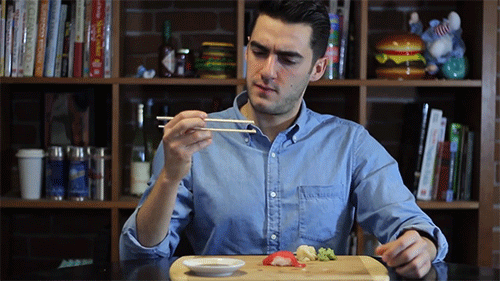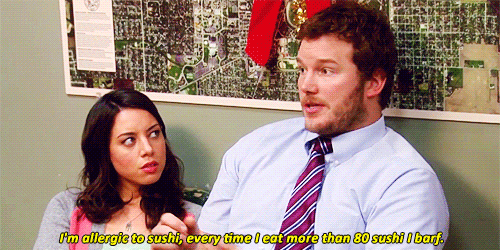Most people love some good sushi. They stake out their favorite restaurants (and maybe even go decked out in sushi accessories with some sushi nail art). They know all the rules for eating it the right way, and they tell all their friends so they don’t embarrass themselves.
Sometimes, it’s impossible to avoid sushi that just isn’t up to par. But when sushi is good, it’s really good. Follow these guidelines to try and avoid the imposters.
1. Look for a good balance of fish and rice.

Gif courtesy of rebloggy.com
Although everyone has different taste in what sushi they like, there’s one standard that holds for any sushi: you need a good fish-to-rice ratio. This is pretty self-explanatory. It won’t taste good if the proportions are off.
Imagine a peanut butter and jelly sandwich that has three pounds of jelly and a swipe of peanut butter. Ick. We need balance, or food gets gross really quickly.
2. Avoid restaurants that serve everything.

Gif courtesy of giphy.com
If you’re a sushi newbie, you might not know what you’re looking for on a menu or how to find it. It’s one thing if you just don’t know what sushi you want to eat. It’s another if the menu offers sushi and lasagna. And fried rice. And chicken noodle soup.
Basically, if the restaurant isn’t 100% dedicated to selling sushi, it’s not paying its sushi enough attention. And if the sushi isn’t getting attention, it’ll be gross. I promise.
3. Bad restaurants smell fishy.

Gif courtesy of giphy.com
“No, Caitlin,” you cry, “but sushi is fish. Of course it smells fishy. You’re destroying everything I’ve ever known.” Nope. Sushi restaurants shouldn’t smell fishy. Sometimes, if they do, it can mean that the restaurant isn’t being cleaned properly.
Trust me on this one – a world-famous sushi chef said it himself. Usually, he said, a good sushi restaurant should smell like cucumber or watermelon.
4. Small sizes are best.

Gif courtesy of giphy.com
Sushi isn’t about gorging yourself. It’s supposed to be light. You’re supposed to be able to eat it in one bite.
If a sushi place is giving you a roll so fat you can’t cram it in your mouth, chances are it’s not legit. Traditional places focus on flavor over filling.
5. All-you-can-eat is a no-go.

Gif courtesy of giphy.com
Think about it. Sushi is supposed to be high quality. You don’t want to mess around with bad fish. If you can get unlimited sushi for only $12.95, it’s not only lower ingredient quality, but also lower fish quality (can you say stomach ache?).
Chances are, if it’s rolling out quick enough to fill a buffet-level appetite, it’s not being made with care.
6. Avoid unorthodox ingredients.

Gif courtesy of sodahead.com
Sushi is simple. If your roll is stuffed to the gills (see numbers 1 and 4), then that restaurant may just be trying too hard. Anything that seems nontraditional should raise a red flag.
Make sure you check the menu ahead of time to make sure you avoid a snafu.
7. Check reviews first.

Gif courtesy of giphy.com
While this may be the simplest advice, it still holds true. A restaurant can appear to be doing everything right, but who knows what’s really going on inside? Unless there was some weird crazy controversy or a few strange outliers, sites like Yelp tend to be great for weeding out the weaker restaurants.
Check in with the people who’ve already tried it. It’ll keep you from wasting time.

